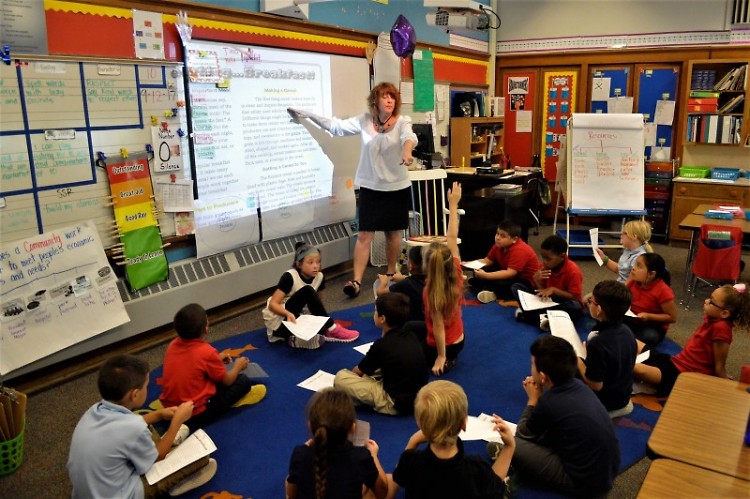By Erin Albanese, School News Network
In light of a new report on Michigan school finances, Kent County area superintendents say there’s no doubt more equitable school funding is needed. Findings show Michigan is dead last among all states in revenue growth for K-12 schools since voters approved Proposal A in 1994, which changed property taxes and school funding.
Drops in achievement statewide have occurred during the same timespan, according to the 91-page report, “Michigan School Finance At The Crossroads: A Quarter Century of State Control”, by lead author David Arsen, professor of Education Policy and K-12 Educational Administration at Michigan State University, and co-authored by doctoral students Tanner Delpier and Jesse Nagel.
Godfrey-Lee Public Schools Superintendent Kevin Polston said the report brings awareness to a stark reality. “What it shows is the correlation between disinvestment in education and drop in rankings (comparing states),” said Polston, who leads Kent County’s highest-poverty district.
Student performance has trended downward. When Proposal A passed, Michigan students performed above the national average on the National Assessment of Education Progress. In recent years, however, Michigan’s NAEP performance has fallen to the bottom tier of states, according to the report. The Education Trust-Midwest found that Michigan is one of five states in which fourth-grade reading performance has declined since 2003. Only West Virginia had a greater decline in reading performance.
“Michigan has tried to improve schools on the cheap, focusing on more accountability and school choice,” Arsen said in a press release. “To make those policies effective, they have to be matched with adequate funding. We have been kidding ourselves to think we can move forward while cutting funding for schools.
The study finds school funding levels are lower than in 1995 in terms of real dollars. “We don’t have to wait any longer,” Arsen said. “We know that this isn’t working.
“Michigan has tried to improve schools on the cheap, focusing on more accountability and school choice... We have been kidding ourselves to think we can move forward while cutting funding for schools.”
The report reaffirms last year’s School Finance Research Collaborative study, which found districts receive more than $2,000 less per student than what’s required to meet state proficiency standards. The gap is even higher for districts with high populations of special education and low-income students and English-language learners. For instance, Grand Rapids Public Schools students include 79 percent qualifying for free or reduced lunch, 25 percent in special education and 20 percent EL.
According to the SFRC study, between $6,249 and $13,920 per-student in additional dollars is needed for low-income, special education and EL students to achieve proficiency.
“We strongly maintain...that changes to the state’s school finance system are essential in order to reverse Michigan’s educational decline,” the report states in its conclusion. “Our funding policy recommendations will establish a vital foundation for needed improvements in teaching and learning.”
Because Michigan schools are operating today on fewer dollars, adjusted for inflation, than in 1995, there are fewer reading specialists, counselors and social workers to fulfill student needs, said Ron Koehler, Kent ISD assistant superintendent. “If we are to have the democracy and economy we desire, we should want for all children what we want for our own children, and we should ask our legislators to vote accordingly.”
“Funding is both inadequate and inequitable, which explains why Michigan schools are struggling to meet increasingly rigorous expectations for students and teachers,” Koehler said
A ‘Broken’ Funding System
John Helmholdt, executive director of external affairs for Grand Rapids Public Schools, said it was “about time” someone studied the reality of the state’s school funding formula since Proposal A took effect. While that reform did reduce property taxes, create a more stable funding source and somewhat reduce inequities between high- and low-funded districts, the MSU report confirms the formula’s inadequacy for districts like GRPS, Helmholdt said.
“The way we fund schools in Michigan is fundamentally broken, and fundamentally stacked against high-needs, high-poverty students who are being shortchanged,” Helmholdt said. “What this demonstrates is the failure of Proposal A and the school funding formula to adequately meet the needs of our highest poverty students.”
He decried the state Legislature and Michigan Department of Education for “expecting increased academic results all the while they are cutting funding,” and for slapping a “one-size-fits-all letter grade” on schools while inadequately funding them.
“We should be ashamed as a state for what we’ve done to our public schools, and even more so to those public schools that serve the highest need, highest poverty students,” he added.
Still, Helmholdt said he’s optimistic this latest report will help spark needed funding reform. He said he’s encouraged by the election of Gov. Gretchen Whitmer, “a champion for public education,” and by more investment in education by the Legislature in recent years.
“Now we have the road map,” Helmholdt said. “Now it’s a matter of having the political will and true leadership coming out of Lansing to step up and take the steps necessary to ensure all children achieve their greatest potential.”
Increased Awareness Builds Optimism
Forest Hills Superintendent Dan Behm said he, too, feels optimistic.
“I am hopeful for our future, even in the wake of this depressing report,” he said. “I think people now more than ever are paying attention, and are beginning to unpack the complexities of how we fund our K-12 schools.”
He thinks the report -- particularly the executive summary -- “finds a way to cut through the complexity.”
“When schools are complaining that we’re losing funding and lawmakers are saying school funding is at an all-time high, it’s these opposing claims that lead the average citizen to think that someone isn’t telling the truth,” Behm said. “It’s no surprise those two very different messages left people in a state of confusion or a state of distrust.
“What (MSU) has done is come up with the ‘translate’ button, found a way to translate those disparate funding (claims) and ‘got to be apples to apples’ in a way others haven’t been able to. That’s the piece that sticks out for me.”
Wyoming Public Schools Superintendent Craig Hoekstra said he’s glad the report is getting public attention. The report recommends base funding of $9,590 for all K-12 students in district and brick-and-mortar charter schools. Wyoming was allocated $7,871 per pupil for the 2018-2019 school year. (Many districts are funded at the $7,871 level.)
“That puts Wyoming nearly $2,000 (per-pupil) under what is adequate,” Hoekstra said. Wyoming enrolls 22 percent of students who are English-language learners and 76 percent are economically disadvantaged. Those students require even more funding.
Hoekstra said more equitable funding would allow for more specialization and differentiated instruction -- meeting the needs of all learners, from those with special needs to high-achieving. That requires more staff, interventionists and programs, which aren’t affordable when dollars are stretched thin.
Hoekstra said he invites any lawmaker to come in and witness learning inside Wyoming schools. “In many ways we are defying the odds,” he said. “No matter what hand is dealt, we will always do what’s best for children.”
A clear example of lawmakers not prioritizing education, he said, was Michigan’s lame duck Legislature’s move last month to shift income tax revenue away from the School Aid Fund and toward road repairs and environmental cleanup.
“Lawmakers need to stop using the School Aid Fund to fill budget gaps,” he said. “I feel very strongly ... that funding other needs off the back of children is just wrong.”
Investment Makes a Difference
Polston, from Godfrey-Lee, has a concrete example of how increased funding can boost achievement. When additional grant funding was available, the district was able to hire more staff members and achievement soared. After those dollars ended, scored dropped.
In 2010, Lee High School was placed on the list of the lowest 5 percent of schools in achievement, according to the state’s Top-to Bottom list rankings. Because of the designation, the district received a $2.1 million School Improvement Grant to implement new programs and staffing. Results were positive, and the district was allocated another $900,000 in SIG funding in 2013.
The state recently lifted Lee’s designation as a Priority School because of the ranking following four years during which the school saw a huge spike in achievement in standardized test scores, and then another big drop. Scores rose after SIG funding allowed for more programs and staffing, and then decreased again once funds ended and much of what had been added was lost.
“When you invest in research-based strategies and staff, it works,” he said.
Needs vary district to district, he said. Godfrey-Lee is unique as the smallest district in Kent County with 50 percent English-language learners and more than 90 percent economically disadvantaged students. Because of its low tax base, the district cannot rely on bond funding to replace and upgrade facilities.
With increased revenue, the district could better fund infrastructure needs, reduce class sizes and add support staff including English-learning support, he said.
Districts bearing the brunt of the state’s moves to cut funding and dip into funds earmarked for education is wrong, Polston said.
“Moving money out of the School Aid Fund has got to stop. It’s not what the purpose of Proposal A was.
“Our kids deserve better.”
Charles Honey and Morgan Jarema contributed to this report


